Macroeconomic Factors Influencing Australia's GDP Growth in 2017
VerifiedAdded on 2023/06/13
|10
|1687
|75
Report
AI Summary
This report provides a macroeconomic analysis of Australia's GDP growth in 2017, based on an article discussing the country's economic performance. It highlights key aspects such as the 2.4 percent GDP growth rate, which fell below the forecasted long-term rate, and examines the impact of various factors including consumer spending, net exports, and the construction sector. The report also addresses wage growth, productivity, and the declining saving rate, assessing their influence on the overall economic outlook. Treasurer Scott Morrison's optimistic perspective is contrasted with concerns about weak productivity and the need for the Reserve Bank of Australia (RBA) to adjust its economic recovery timeline. The analysis references data from the Australian Bureau of Statistics and insights from economists, providing a comprehensive overview of Australia's economic landscape during that period. Desklib provides access to similar solved assignments and study tools for students.

Running Head: FOUNDATION FOR MACROECONOMICS
Foundation for Macroeconomics
Name of the Student
Name of the University
Author note
Foundation for Macroeconomics
Name of the Student
Name of the University
Author note
Paraphrase This Document
Need a fresh take? Get an instant paraphrase of this document with our AI Paraphraser
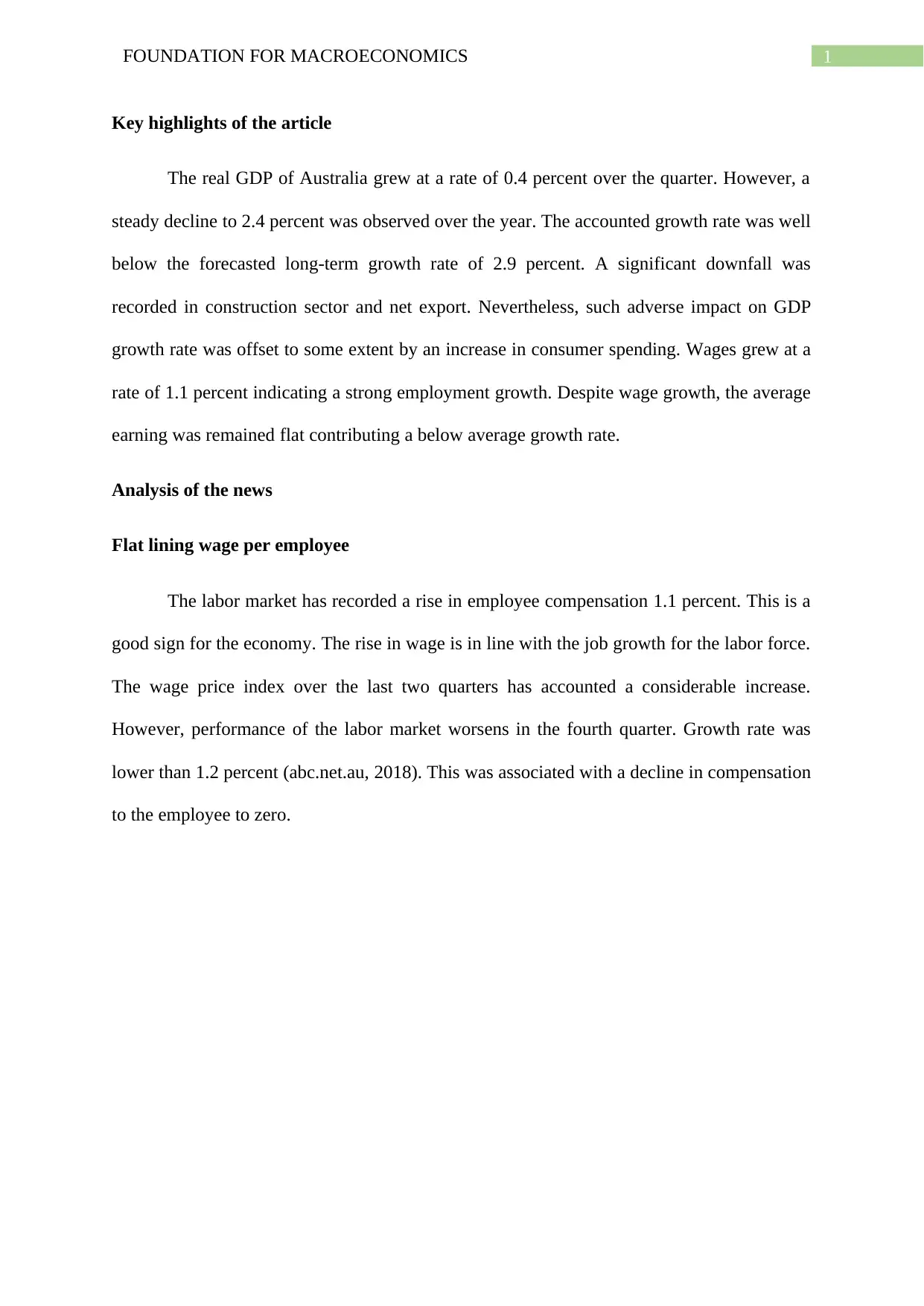
1FOUNDATION FOR MACROECONOMICS
Key highlights of the article
The real GDP of Australia grew at a rate of 0.4 percent over the quarter. However, a
steady decline to 2.4 percent was observed over the year. The accounted growth rate was well
below the forecasted long-term growth rate of 2.9 percent. A significant downfall was
recorded in construction sector and net export. Nevertheless, such adverse impact on GDP
growth rate was offset to some extent by an increase in consumer spending. Wages grew at a
rate of 1.1 percent indicating a strong employment growth. Despite wage growth, the average
earning was remained flat contributing a below average growth rate.
Analysis of the news
Flat lining wage per employee
The labor market has recorded a rise in employee compensation 1.1 percent. This is a
good sign for the economy. The rise in wage is in line with the job growth for the labor force.
The wage price index over the last two quarters has accounted a considerable increase.
However, performance of the labor market worsens in the fourth quarter. Growth rate was
lower than 1.2 percent (abc.net.au, 2018). This was associated with a decline in compensation
to the employee to zero.
Key highlights of the article
The real GDP of Australia grew at a rate of 0.4 percent over the quarter. However, a
steady decline to 2.4 percent was observed over the year. The accounted growth rate was well
below the forecasted long-term growth rate of 2.9 percent. A significant downfall was
recorded in construction sector and net export. Nevertheless, such adverse impact on GDP
growth rate was offset to some extent by an increase in consumer spending. Wages grew at a
rate of 1.1 percent indicating a strong employment growth. Despite wage growth, the average
earning was remained flat contributing a below average growth rate.
Analysis of the news
Flat lining wage per employee
The labor market has recorded a rise in employee compensation 1.1 percent. This is a
good sign for the economy. The rise in wage is in line with the job growth for the labor force.
The wage price index over the last two quarters has accounted a considerable increase.
However, performance of the labor market worsens in the fourth quarter. Growth rate was
lower than 1.2 percent (abc.net.au, 2018). This was associated with a decline in compensation
to the employee to zero.

2FOUNDATION FOR MACROECONOMICS
Optimistic outlook of treasurer
Despite slow growth figures in 2017, treasurer Scott Morrison has a positive outlook
for the future. The National account of Australia showed a reliance resulting from the ability
of citizens to support themselves with a high capacity to spend and invest. This provides an
optimistic fiscal and economic outlook. Confidence of the household and domestic spending
is the biggest contributor of economic growth. Since the fourth quarter of 2010, strong
growth in consumer spending is observed (ft.com, 2018). Household consumption being one
of the major component of GDP has made a positive contribution to economic growth rate
(Bernanke, Antonovics & Frank, 2015). The growth in consumer spending was driven by an
increase in average wage rather than total wage bill.
Weak productivity growth
Productivity is an important determinant of economic growth. A higher growth in
productivity determines a higher growth of economy’s output (Heijdra, 2017). Last year,
there was a growth in employment by 2.2 percent. This naturally made the output to grow at a
Optimistic outlook of treasurer
Despite slow growth figures in 2017, treasurer Scott Morrison has a positive outlook
for the future. The National account of Australia showed a reliance resulting from the ability
of citizens to support themselves with a high capacity to spend and invest. This provides an
optimistic fiscal and economic outlook. Confidence of the household and domestic spending
is the biggest contributor of economic growth. Since the fourth quarter of 2010, strong
growth in consumer spending is observed (ft.com, 2018). Household consumption being one
of the major component of GDP has made a positive contribution to economic growth rate
(Bernanke, Antonovics & Frank, 2015). The growth in consumer spending was driven by an
increase in average wage rather than total wage bill.
Weak productivity growth
Productivity is an important determinant of economic growth. A higher growth in
productivity determines a higher growth of economy’s output (Heijdra, 2017). Last year,
there was a growth in employment by 2.2 percent. This naturally made the output to grow at a
⊘ This is a preview!⊘
Do you want full access?
Subscribe today to unlock all pages.

Trusted by 1+ million students worldwide
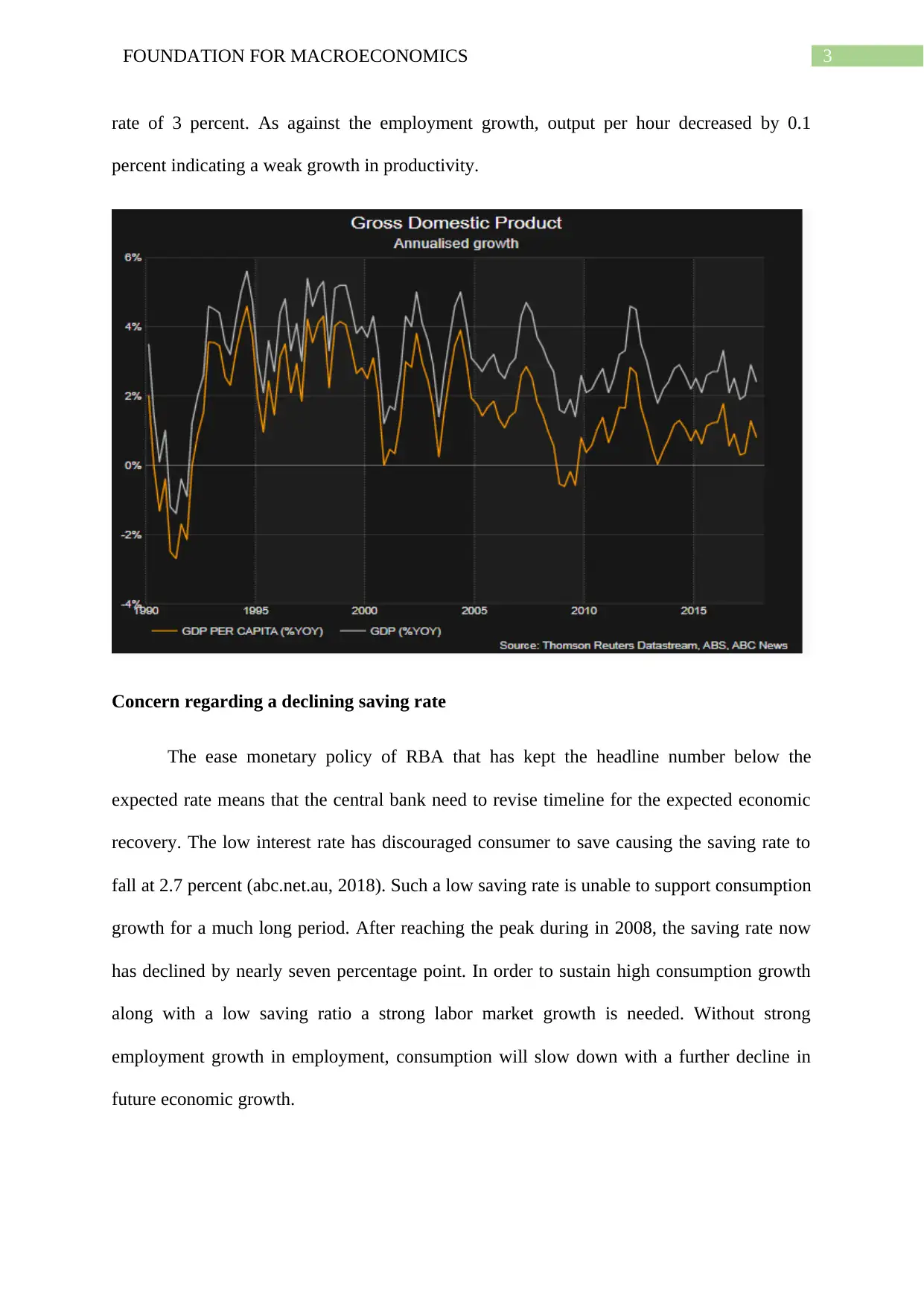
3FOUNDATION FOR MACROECONOMICS
rate of 3 percent. As against the employment growth, output per hour decreased by 0.1
percent indicating a weak growth in productivity.
Concern regarding a declining saving rate
The ease monetary policy of RBA that has kept the headline number below the
expected rate means that the central bank need to revise timeline for the expected economic
recovery. The low interest rate has discouraged consumer to save causing the saving rate to
fall at 2.7 percent (abc.net.au, 2018). Such a low saving rate is unable to support consumption
growth for a much long period. After reaching the peak during in 2008, the saving rate now
has declined by nearly seven percentage point. In order to sustain high consumption growth
along with a low saving ratio a strong labor market growth is needed. Without strong
employment growth in employment, consumption will slow down with a further decline in
future economic growth.
rate of 3 percent. As against the employment growth, output per hour decreased by 0.1
percent indicating a weak growth in productivity.
Concern regarding a declining saving rate
The ease monetary policy of RBA that has kept the headline number below the
expected rate means that the central bank need to revise timeline for the expected economic
recovery. The low interest rate has discouraged consumer to save causing the saving rate to
fall at 2.7 percent (abc.net.au, 2018). Such a low saving rate is unable to support consumption
growth for a much long period. After reaching the peak during in 2008, the saving rate now
has declined by nearly seven percentage point. In order to sustain high consumption growth
along with a low saving ratio a strong labor market growth is needed. Without strong
employment growth in employment, consumption will slow down with a further decline in
future economic growth.
Paraphrase This Document
Need a fresh take? Get an instant paraphrase of this document with our AI Paraphraser

4FOUNDATION FOR MACROECONOMICS
References
Australia Q4 GDP growth slows to 0.4%. (2018). Ft.com. Retrieved 3 April 2018, from
https://www.ft.com/content/9de1f992-219d-11e8-a895-1ba1f72c2c11
Australia's economy grew by 2.4 per cent in 2017, below expectations. (2018). ABC News.
Retrieved 3 April 2018, from http://www.abc.net.au/news/2018-03-07/gdp-q4-
2017/9522450
Bernanke, B., Antonovics, K., & Frank, R. (2015). Principles of macroeconomics. McGraw-
Hill Higher Education.
Heijdra, B. J. (2017). Foundations of modern macroeconomics. Oxford university press.
References
Australia Q4 GDP growth slows to 0.4%. (2018). Ft.com. Retrieved 3 April 2018, from
https://www.ft.com/content/9de1f992-219d-11e8-a895-1ba1f72c2c11
Australia's economy grew by 2.4 per cent in 2017, below expectations. (2018). ABC News.
Retrieved 3 April 2018, from http://www.abc.net.au/news/2018-03-07/gdp-q4-
2017/9522450
Bernanke, B., Antonovics, K., & Frank, R. (2015). Principles of macroeconomics. McGraw-
Hill Higher Education.
Heijdra, B. J. (2017). Foundations of modern macroeconomics. Oxford university press.
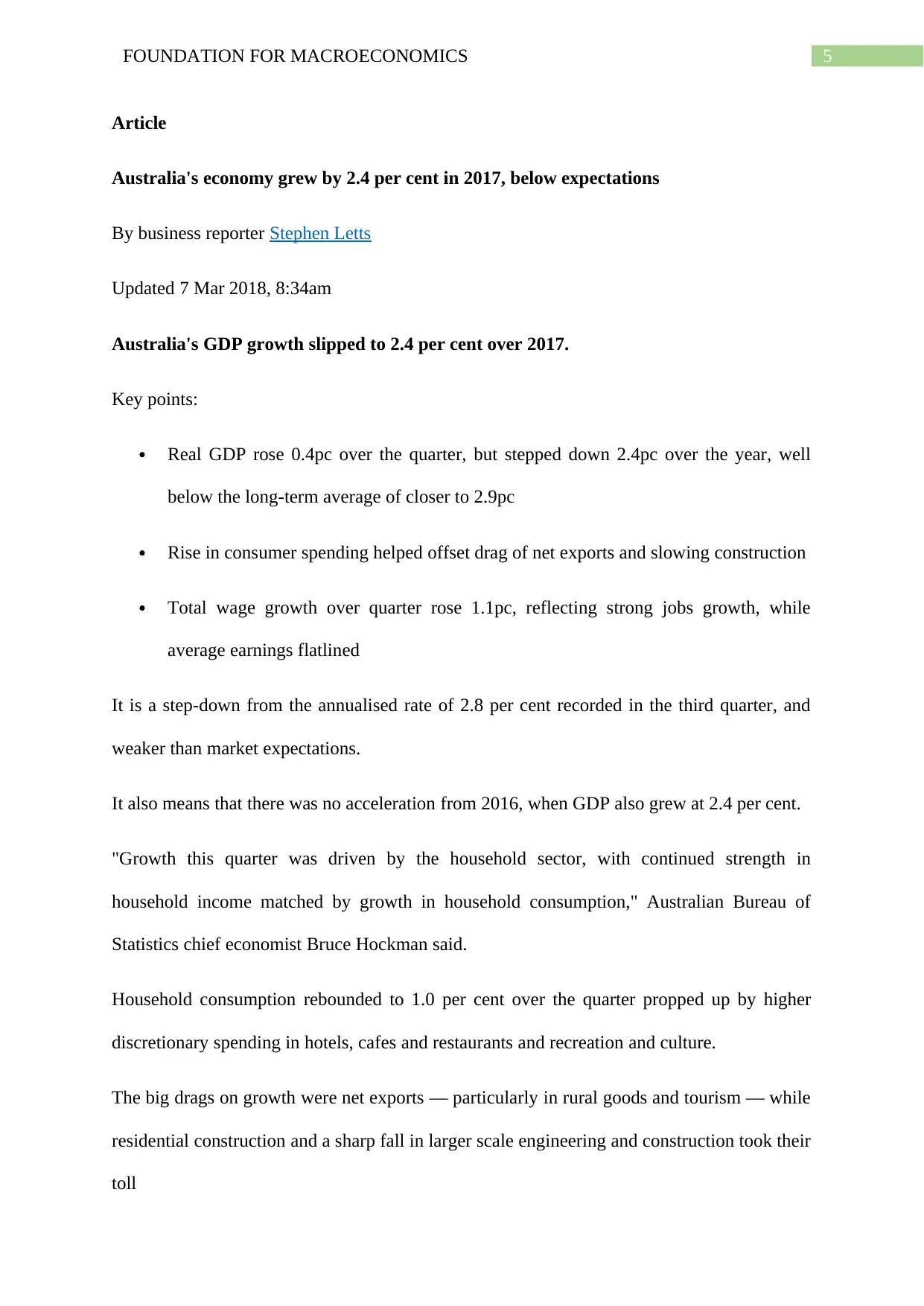
5FOUNDATION FOR MACROECONOMICS
Article
Australia's economy grew by 2.4 per cent in 2017, below expectations
By business reporter Stephen Letts
Updated 7 Mar 2018, 8:34am
Australia's GDP growth slipped to 2.4 per cent over 2017.
Key points:
Real GDP rose 0.4pc over the quarter, but stepped down 2.4pc over the year, well
below the long-term average of closer to 2.9pc
Rise in consumer spending helped offset drag of net exports and slowing construction
Total wage growth over quarter rose 1.1pc, reflecting strong jobs growth, while
average earnings flatlined
It is a step-down from the annualised rate of 2.8 per cent recorded in the third quarter, and
weaker than market expectations.
It also means that there was no acceleration from 2016, when GDP also grew at 2.4 per cent.
"Growth this quarter was driven by the household sector, with continued strength in
household income matched by growth in household consumption," Australian Bureau of
Statistics chief economist Bruce Hockman said.
Household consumption rebounded to 1.0 per cent over the quarter propped up by higher
discretionary spending in hotels, cafes and restaurants and recreation and culture.
The big drags on growth were net exports — particularly in rural goods and tourism — while
residential construction and a sharp fall in larger scale engineering and construction took their
toll
Article
Australia's economy grew by 2.4 per cent in 2017, below expectations
By business reporter Stephen Letts
Updated 7 Mar 2018, 8:34am
Australia's GDP growth slipped to 2.4 per cent over 2017.
Key points:
Real GDP rose 0.4pc over the quarter, but stepped down 2.4pc over the year, well
below the long-term average of closer to 2.9pc
Rise in consumer spending helped offset drag of net exports and slowing construction
Total wage growth over quarter rose 1.1pc, reflecting strong jobs growth, while
average earnings flatlined
It is a step-down from the annualised rate of 2.8 per cent recorded in the third quarter, and
weaker than market expectations.
It also means that there was no acceleration from 2016, when GDP also grew at 2.4 per cent.
"Growth this quarter was driven by the household sector, with continued strength in
household income matched by growth in household consumption," Australian Bureau of
Statistics chief economist Bruce Hockman said.
Household consumption rebounded to 1.0 per cent over the quarter propped up by higher
discretionary spending in hotels, cafes and restaurants and recreation and culture.
The big drags on growth were net exports — particularly in rural goods and tourism — while
residential construction and a sharp fall in larger scale engineering and construction took their
toll
⊘ This is a preview!⊘
Do you want full access?
Subscribe today to unlock all pages.

Trusted by 1+ million students worldwide

6FOUNDATION FOR MACROECONOMICS
Wages per employee flatlining
Mr Hockman said a 1.1 per cent increase in employee compensation was a "solid" result.
"The increase in wages is consistent with stronger employment data reported in Labour
Force, as well as a lift in the growth rate in the wage price index observed over the past two
quarters," Mr Hockman said.
However, wage growth was slower than the 1.2 per cent recorded in the third quarter, while
average compensation per employee — which takes population growth out of the equation —
fell to zero over the quarter, the worst performance in two years.
Wages per employee flatlining
Mr Hockman said a 1.1 per cent increase in employee compensation was a "solid" result.
"The increase in wages is consistent with stronger employment data reported in Labour
Force, as well as a lift in the growth rate in the wage price index observed over the past two
quarters," Mr Hockman said.
However, wage growth was slower than the 1.2 per cent recorded in the third quarter, while
average compensation per employee — which takes population growth out of the equation —
fell to zero over the quarter, the worst performance in two years.
Paraphrase This Document
Need a fresh take? Get an instant paraphrase of this document with our AI Paraphraser
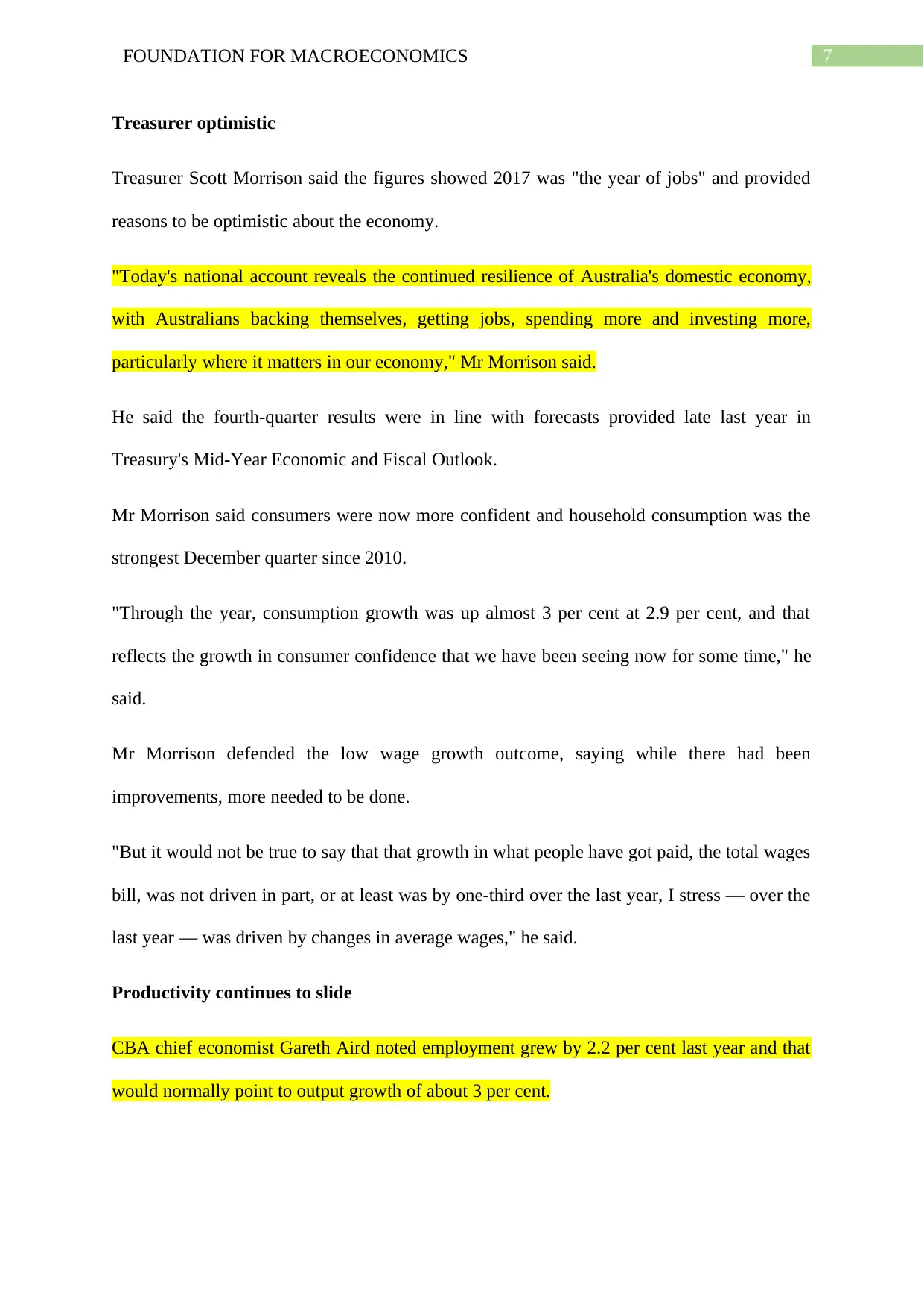
7FOUNDATION FOR MACROECONOMICS
Treasurer optimistic
Treasurer Scott Morrison said the figures showed 2017 was "the year of jobs" and provided
reasons to be optimistic about the economy.
"Today's national account reveals the continued resilience of Australia's domestic economy,
with Australians backing themselves, getting jobs, spending more and investing more,
particularly where it matters in our economy," Mr Morrison said.
He said the fourth-quarter results were in line with forecasts provided late last year in
Treasury's Mid-Year Economic and Fiscal Outlook.
Mr Morrison said consumers were now more confident and household consumption was the
strongest December quarter since 2010.
"Through the year, consumption growth was up almost 3 per cent at 2.9 per cent, and that
reflects the growth in consumer confidence that we have been seeing now for some time," he
said.
Mr Morrison defended the low wage growth outcome, saying while there had been
improvements, more needed to be done.
"But it would not be true to say that that growth in what people have got paid, the total wages
bill, was not driven in part, or at least was by one-third over the last year, I stress — over the
last year — was driven by changes in average wages," he said.
Productivity continues to slide
CBA chief economist Gareth Aird noted employment grew by 2.2 per cent last year and that
would normally point to output growth of about 3 per cent.
Treasurer optimistic
Treasurer Scott Morrison said the figures showed 2017 was "the year of jobs" and provided
reasons to be optimistic about the economy.
"Today's national account reveals the continued resilience of Australia's domestic economy,
with Australians backing themselves, getting jobs, spending more and investing more,
particularly where it matters in our economy," Mr Morrison said.
He said the fourth-quarter results were in line with forecasts provided late last year in
Treasury's Mid-Year Economic and Fiscal Outlook.
Mr Morrison said consumers were now more confident and household consumption was the
strongest December quarter since 2010.
"Through the year, consumption growth was up almost 3 per cent at 2.9 per cent, and that
reflects the growth in consumer confidence that we have been seeing now for some time," he
said.
Mr Morrison defended the low wage growth outcome, saying while there had been
improvements, more needed to be done.
"But it would not be true to say that that growth in what people have got paid, the total wages
bill, was not driven in part, or at least was by one-third over the last year, I stress — over the
last year — was driven by changes in average wages," he said.
Productivity continues to slide
CBA chief economist Gareth Aird noted employment grew by 2.2 per cent last year and that
would normally point to output growth of about 3 per cent.
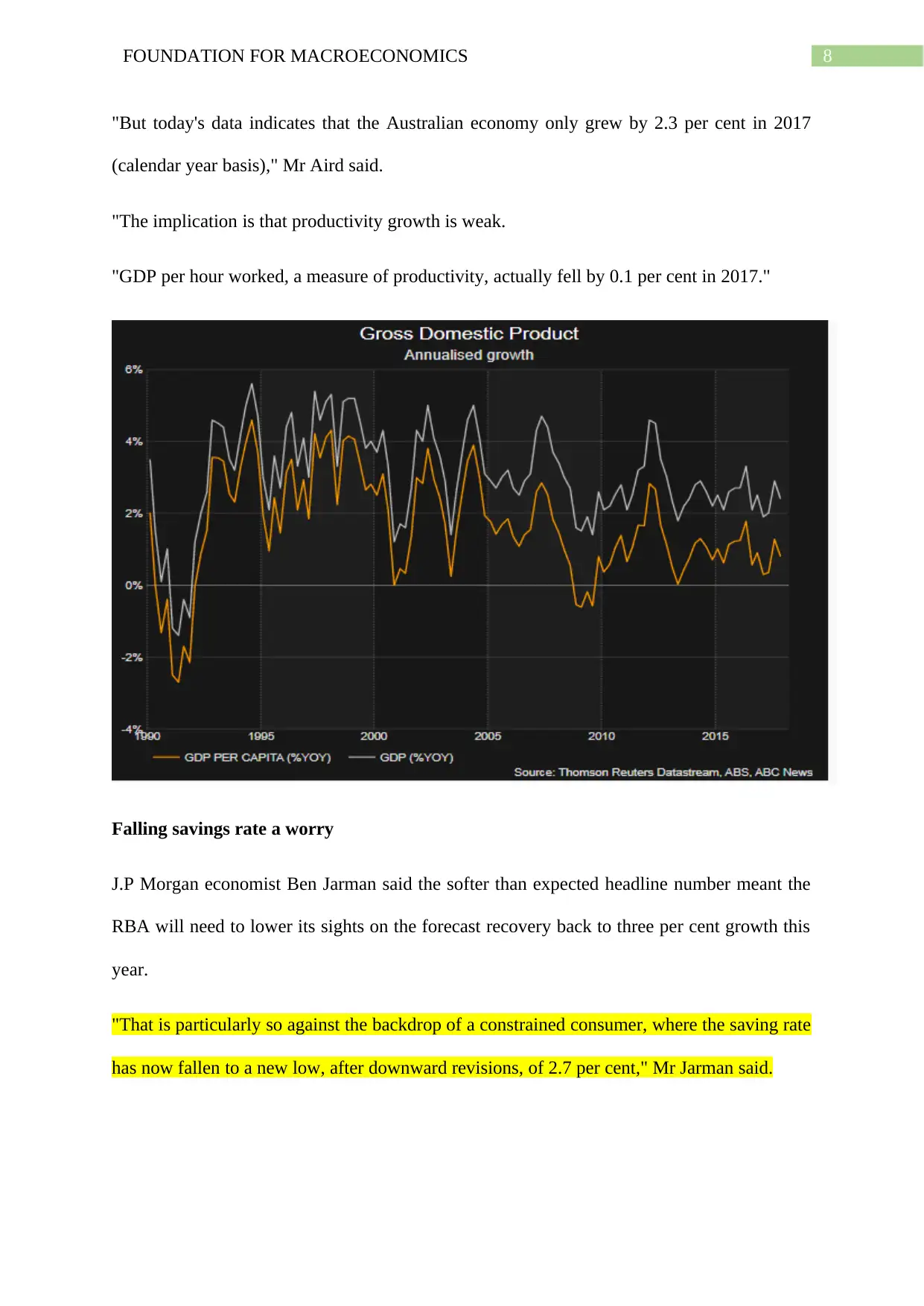
8FOUNDATION FOR MACROECONOMICS
"But today's data indicates that the Australian economy only grew by 2.3 per cent in 2017
(calendar year basis)," Mr Aird said.
"The implication is that productivity growth is weak.
"GDP per hour worked, a measure of productivity, actually fell by 0.1 per cent in 2017."
Falling savings rate a worry
J.P Morgan economist Ben Jarman said the softer than expected headline number meant the
RBA will need to lower its sights on the forecast recovery back to three per cent growth this
year.
"That is particularly so against the backdrop of a constrained consumer, where the saving rate
has now fallen to a new low, after downward revisions, of 2.7 per cent," Mr Jarman said.
"But today's data indicates that the Australian economy only grew by 2.3 per cent in 2017
(calendar year basis)," Mr Aird said.
"The implication is that productivity growth is weak.
"GDP per hour worked, a measure of productivity, actually fell by 0.1 per cent in 2017."
Falling savings rate a worry
J.P Morgan economist Ben Jarman said the softer than expected headline number meant the
RBA will need to lower its sights on the forecast recovery back to three per cent growth this
year.
"That is particularly so against the backdrop of a constrained consumer, where the saving rate
has now fallen to a new low, after downward revisions, of 2.7 per cent," Mr Jarman said.
⊘ This is a preview!⊘
Do you want full access?
Subscribe today to unlock all pages.

Trusted by 1+ million students worldwide

9FOUNDATION FOR MACROECONOMICS
Mr Jarman said the concern with the declining savings rate — with the third quarter figure
also revised down — was that it will not be able to prop up consumption for much longer
without continued strong jobs growth.
"The saving rate has now fallen nearly seven percentage points from its financial crisis-period
peak in 2008," he said.
"This has been very supportive for consumption growth in recent years, and so without
further downward adjustment in the saving rate, 2017's very strong rate of labour force
growth would have to be maintained — which is not forecast — otherwise consumption will
decelerate."
Mr Jarman said the Reserve Bank's most recent quarterly Statement on Monetary Policy
released just last month was already looking dated.
"The [RBA] staff projected 3.25 percent over the year growth by year-end 2018 in the
February SoMP, though the Governor's language in the last couple of days reflects some
back-pedalling from this," he said.
"Another set of downward revisions in the next forecast round in May would underscore the
fact that the RBA will lag the global rate normalization process by some distance."
Mr Jarman said the concern with the declining savings rate — with the third quarter figure
also revised down — was that it will not be able to prop up consumption for much longer
without continued strong jobs growth.
"The saving rate has now fallen nearly seven percentage points from its financial crisis-period
peak in 2008," he said.
"This has been very supportive for consumption growth in recent years, and so without
further downward adjustment in the saving rate, 2017's very strong rate of labour force
growth would have to be maintained — which is not forecast — otherwise consumption will
decelerate."
Mr Jarman said the Reserve Bank's most recent quarterly Statement on Monetary Policy
released just last month was already looking dated.
"The [RBA] staff projected 3.25 percent over the year growth by year-end 2018 in the
February SoMP, though the Governor's language in the last couple of days reflects some
back-pedalling from this," he said.
"Another set of downward revisions in the next forecast round in May would underscore the
fact that the RBA will lag the global rate normalization process by some distance."
1 out of 10
Related Documents
Your All-in-One AI-Powered Toolkit for Academic Success.
+13062052269
info@desklib.com
Available 24*7 on WhatsApp / Email
![[object Object]](/_next/static/media/star-bottom.7253800d.svg)
Unlock your academic potential
Copyright © 2020–2025 A2Z Services. All Rights Reserved. Developed and managed by ZUCOL.




